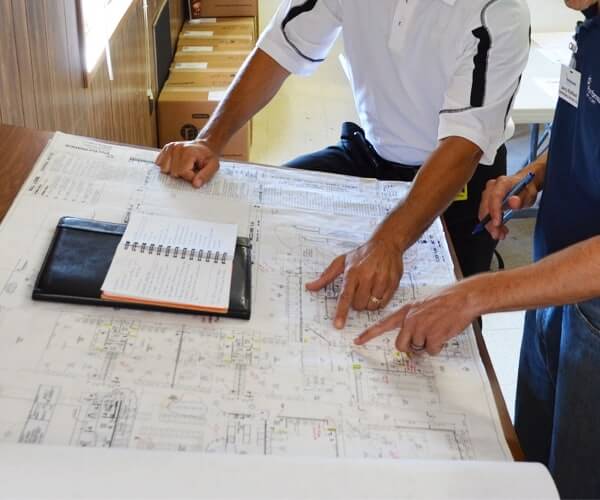How to Begin the K-12 Renovation Process
September 17, 2014

Most school corporations in today’s unforgiving financial environment have huge facility needs, but not the corresponding budget room to accomplish everything that needs to be done. So, as a superintendent, school business manager, or maintenance director, how do you help your school board prioritize where to spend those valuable dollars first?
When I came into my position as superintendent at Randolph Eastern School Corporation, we were exactly in the position described above – many needs, not enough dollars, and no long-term plan. We were also in the middle of a forest of activities. We had previously contracted a company to come in to look at our roofs and make some recommendations. We were also in the midst of an HVAC/electrical project in our high school; one that frankly was not going very well at the time I took over. The board was in the process of making a decision to close a middle school that was over 80 years old and adding on to the high school to create a combined K-12 campus. Then we made an unfortunate discovery. The HVAC project we had just carried out did not, in fact, deliver us the capacity to create that campus, even though the previous designers had assured us it would.
I started calling colleagues all around the state, asking just where I could get some help with my current issues and some support with future planning. We checked out many architectural and engineering firms, who all wanted initial payment to do a study of our facilities. The upside of the initial payment for the study was that, if we did a major building project with them, we would get a discount on their work. But my board was already spending all the money we had available through our bond issue to build the addition. Our Capital Projects fund was extremely small and already designated for ongoing technology and maintenance issues.

We kept searching, and finally found a company that not only did Guaranteed Energy Savings Contracts, but it was also highly recommended by its previous clients. Considering a huge part of our issues seemed to be either HVAC or roof related or building envelope challenges, we thought a guaranteed energy savings approach might well be the way to go. However, the school board had been told by previous administrators to stay away from Guaranteed Energy Savings Contracts (GESC). We also had a Clerk of the Works for the current building project who had past negative experiences with the old type of GESCs.
Yet, in the face of all these issues, the board took a leap of faith and asked for a comprehensive facility study, which included educational programming and an engineering study of our buildings. The report was then presented to our school board and commenced a 10-year facilities plan, which our school board adopted and used as its master plan for building renovations and projects. So not only did this plan prove itself as a valuable tool at the time it was created in 2004. It then went on to become a vital part of our ongoing planning process, especially after Randolph Eastern found out that the Circuit Breaker losses for their tax funds would be close to 20 percent! Each year now, as the superintendent and maintenance director work on the three-year Capital Projects Plan for the budget, this plan is updated and used for the budget adoption process.
 Scroll forward ten years and the 2004 Guaranteed Energy Savings Contract is complete and the bond paid off. In a context of limited CPF money, especially due to the circuit breaker losses each year, the corporation is still using the facilities plan and is now ready to do another Guaranteed Energy Savings Project and update that plan. This trust and belief in Guarantee Energy Savings contracts comes from a board that previously had been told such contracts were best avoided! Even the previously skeptical Clerk of the Works became sold on the process and the quality of the ensuing work. Randolph Eastern now has efficient buildings: ENERGY STAR-certified, delivering an optimal learning environment, and all in the context of a comprehensive plan for continuing renovations.
Scroll forward ten years and the 2004 Guaranteed Energy Savings Contract is complete and the bond paid off. In a context of limited CPF money, especially due to the circuit breaker losses each year, the corporation is still using the facilities plan and is now ready to do another Guaranteed Energy Savings Project and update that plan. This trust and belief in Guarantee Energy Savings contracts comes from a board that previously had been told such contracts were best avoided! Even the previously skeptical Clerk of the Works became sold on the process and the quality of the ensuing work. Randolph Eastern now has efficient buildings: ENERGY STAR-certified, delivering an optimal learning environment, and all in the context of a comprehensive plan for continuing renovations.
What would I say is the key learning from our successful experience? Whether the district is large or small, the funds limited or not, a comprehensive facility study, such as the one we commissioned with Performance Services, can be a positive first step to begin the journey towards a K-12 school renovation project. Combined with the right design and the right construction partner, it can help the administration and the school board exchange uncertainty and reactivity for a defined roadmap of renovation projects. A facility study brings clarity to the situation. It will prioritize the needs for you, yield current cost estimates, and provide an invaluable tool for planning.
The Randolph Eastern School Board reviews its 10-year facilities plan every year at budget time. The maintenance director and superintendent have a great tool for financial planning, as well as a timetable for renovations. Even with huge circuit breaker losses, the district has managed to keep its buildings in good shape, maintain learning environment standards, and – crucially – plan for the future. Without this tool, the appropriate financing mechanism, and the right partner, project delivery could have been hit and miss as well as leading to increased costs.
Because of the clearly structured approach the school corporation pursued, future needs are well planned, and students can continue benefiting from the all-important optimal learning environment. There is no doubt that knowing what we wanted to accomplish and understanding the key stages leading to that destination played a huge role in our success. If you want to get your priorities right for the long term, you have to understand what they are from the start.

